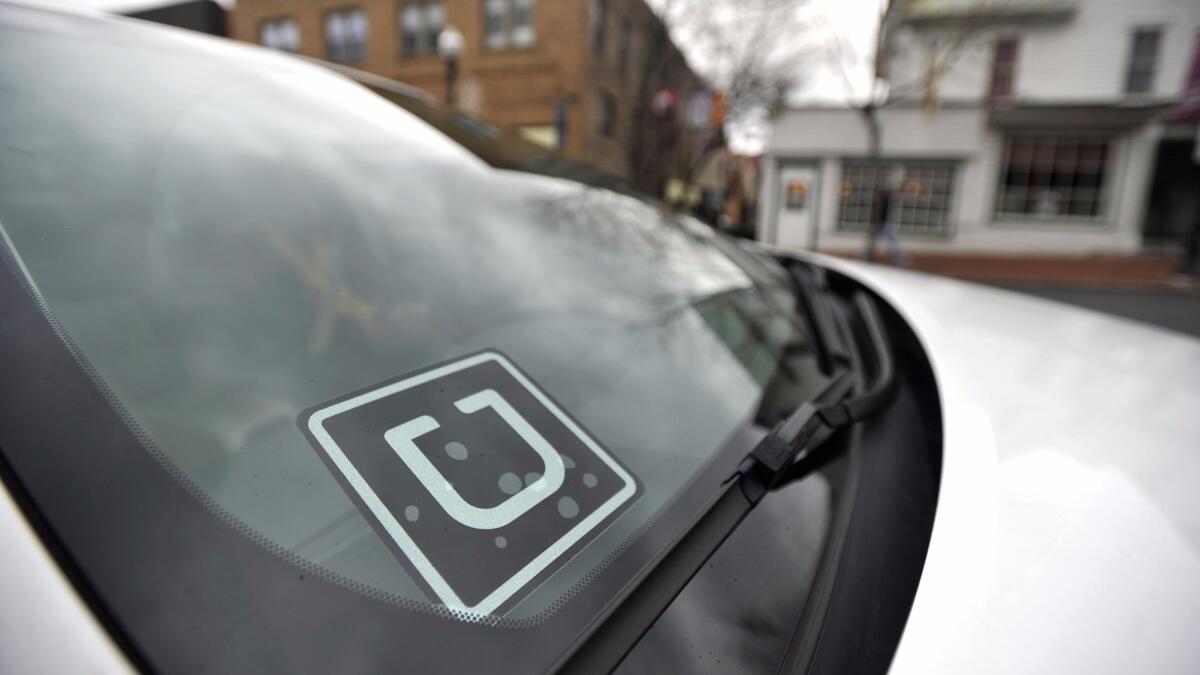California Journal: Uber across the border into Mexico? A new service fails to live up to its hype

Reporting from SAN YSIDRO — I was standing on the sidewalk outside La Bodega, a bustling grocery store on West Olive Avenue, awaiting my Uber driver. I could see from the app that Alejandro and his white Nissan Sentra were four minutes away. He would whisk me across the border into Mexico.
On the other side of San Ysidro Boulevard, in the distance, the hills of Tijuana shimmered in the late afternoon haze.
This was going to be an adventure.
Two months ago, to great fanfare, San Francisco-based Uber announced a cross-border service, apparently the first for a smartphone transportation app. Riders would be able to order an Uber to cross into Mexico from the San Diego area. You could Uber to Tijuana! Or Rosarito Beach!
Or so they said.
See the most-read stories this hour >>
The launch was hailed as big news in San Diego. Mayor Kevin Faulconer said the service “highlights the best of what San Diego has to offer by using one of the world’s most innovative apps to bridge countries, businesses and families in a way that has never been done before.”
Uber’s head of global operations, Ryan Graves, proclaimed that “connecting and celebrating great cities like San Diego and Tijuana is right in Uber’s wheelhouse.”
The vice president of international business affairs for the San Diego Regional Chamber of Commerce was equally enthusiastic: “This is an affordable option that increases efficiency and reduces commute time,” Paola Avila said.
I am a Lyft person, but Ubering to TJ seemed like a cool thing to do. I downloaded the app.
::
“I’m going to a cafe in the Hipodromo neighborhood,” I told Alejandro.
He was very apologetic. “I can’t cross the border,” he said, then explained that only certain Uber drivers were qualified to cross, and that I had to contact them by tapping the word “Passport” at the bottom of the Uber screen (where you choose the type of car you want — UberX, UberBlack, UberSUV and so on).
Except “Passport” didn’t appear on my screen, and I had no idea how to get it.
Alejandro showed me on his phone. He clicked on the Passport button. As it turns out, it wouldn’t have mattered if I’d had the Passport option anyway. His screen said there were no cars available. I asked him to cancel my ride with him. He was gracious about the mix-up. Maybe this idea was a bust.
A few minutes later, I decided, what the hell, I’ll just take an Uber to the border and walk across. If I couldn’t enter Mexico as a member of the shiny new sharing economy, at least I’d be able to see the new pedestrian lanes, which opened last summer to accommodate the estimated 22,000 people who walk into Tijuana from San Ysidro every day.
Join the conversation on Facebook >>
Entering Mexico has always been a breeze. Cars are usually waved through. There is rarely any kind of wait. Pedestrians still pretty much amble across, even though foreign nationals (like me) are now required to show passports.
It’s the return trip that is usually a multi-hour nightmare, as drivers and pedestrians must pass muster with U.S. Customs and Border Patrol agents. The only salvation is a SENTRI pass, which requires a background check, fingerprinting and a face-to-face interview with a Customs and Border Protection officer. Salvation is allegedly on the way, as more lanes are under construction. But for now, without SENTRI, the lines are ridiculous, whether you are entering the U.S. in a car or on foot.
Nothing about Uber’s Passport service changes any of that; you can Uber into Mexico, but you’re on your own when it comes to crossing back. You still have to wait in line to re-enter the U.S., then figure out transportation on the other side.
So who on Earth really uses this service?
::
Uber would not give me any information about ridership, or tell me how many of its drivers are qualified to cross into Mexico.
I asked a spokeswoman why I was unable to find the Passport button on my app.
Turns out the Passport option shows up only if you are a San Diego-area user who has already made trips to or near the border. Anyone else (like me) would have to find a link on Uber’s blog and request it. When I did that, I got a message saying it would take between 24 and 48 hours for the button to appear. I was not informed that I would also need to be south of the San Diego County line.
So could the company at least tell me why, when Alejandro showed me how to use the Passport option, there were no drivers available?
Nope. The spokeswoman told me she had not heard of that ever happening. She assured me the company would not have launched the international service without a healthy supply of drivers.
OK, so I figured I had screwed up. This happens occasionally.
But just to be sure, I called Jennifer Van Grove, a reporter for the San Diego Union-Tribune who covers e-commerce. I asked her if she’d mind opening her Uber app, hitting the Passport button, and telling me what she saw.
She emailed me a screen shot: “No drivers available.”
Well, I guess it wasn’t me after all.
Uber’s San Diego operations team, I have been assured, is all over it.
[email protected] | @AbcarianLAT
ALSO
Horse owners in the San Fernando Valley feel trod on by bullet train
Padres discipline employee after San Diego Gay Men’s Chorus is drowned out singing national anthem
Muslim group on helping San Bernardino shooters’ family: No one should suffer for the sins of others







